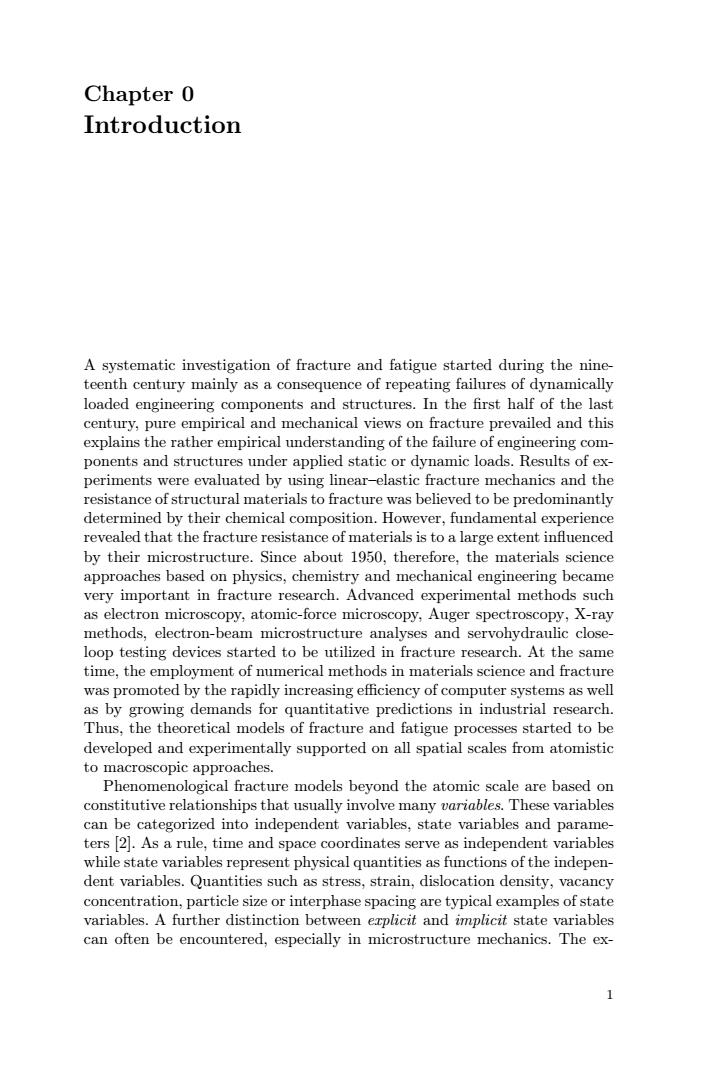正在加载图片...

Chapter 0 Introduction A systematic investigation of fracture and fatigue started during the nine- teenth century mainly as a consequence of repeating failures of dynamically loaded engineering components and structures.In the first half of the last century,pure empirical and mechanical views on fracture prevailed and this explains the rather empirical understanding of the failure of engineering com- ponents and structures under applied static or dynamic loads.Results of ex- periments were evaluated by using linear-elastic fracture mechanics and the resistance of structural materials to fracture was believed to be predominantly determined by their chemical composition.However,fundamental experience revealed that the fracture resistance of materials is to a large extent influenced by their microstructure.Since about 1950,therefore,the materials science approaches based on physics,chemistry and mechanical engineering became very important in fracture research.Advanced experimental methods such as electron microscopy,atomic-force microscopy,Auger spectroscopy,X-ray methods,electron-beam microstructure analyses and servohydraulic close- loop testing devices started to be utilized in fracture research.At the same time,the employment of numerical methods in materials science and fracture was promoted by the rapidly increasing efficiency of computer systems as well as by growing demands for quantitative predictions in industrial research. Thus,the theoretical models of fracture and fatigue processes started to be developed and experimentally supported on all spatial scales from atomistic to macroscopic approaches. Phenomenological fracture models beyond the atomic scale are based on constitutive relationships that usually involve many variables.These variables can be categorized into independent variables,state variables and parame- ters [2].As a rule,time and space coordinates serve as independent variables while state variables represent physical quantities as functions of the indepen- dent variables.Quantities such as stress,strain,dislocation density,vacancy concentration,particle size or interphase spacing are typical examples of state variables.A further distinction between explicit and implicit state variables can often be encountered,especially in microstructure mechanics.The ex- 1Chapter 0 Introduction A systematic investigation of fracture and fatigue started during the nineteenth century mainly as a consequence of repeating failures of dynamically loaded engineering components and structures. In the first half of the last century, pure empirical and mechanical views on fracture prevailed and this explains the rather empirical understanding of the failure of engineering components and structures under applied static or dynamic loads. Results of experiments were evaluated by using linear–elastic fracture mechanics and the resistance of structural materials to fracture was believed to be predominantly determined by their chemical composition. However, fundamental experience revealed that the fracture resistance of materials is to a large extent influenced by their microstructure. Since about 1950, therefore, the materials science approaches based on physics, chemistry and mechanical engineering became very important in fracture research. Advanced experimental methods such as electron microscopy, atomic-force microscopy, Auger spectroscopy, X-ray methods, electron-beam microstructure analyses and servohydraulic closeloop testing devices started to be utilized in fracture research. At the same time, the employment of numerical methods in materials science and fracture was promoted by the rapidly increasing efficiency of computer systems as well as by growing demands for quantitative predictions in industrial research. Thus, the theoretical models of fracture and fatigue processes started to be developed and experimentally supported on all spatial scales from atomistic to macroscopic approaches. Phenomenological fracture models beyond the atomic scale are based on constitutive relationships that usually involve many variables. These variables can be categorized into independent variables, state variables and parameters [2]. As a rule, time and space coordinates serve as independent variables while state variables represent physical quantities as functions of the independent variables. Quantities such as stress, strain, dislocation density, vacancy concentration, particle size or interphase spacing are typical examples of state variables. A further distinction between explicit and implicit state variables can often be encountered, especially in microstructure mechanics. The ex- 1